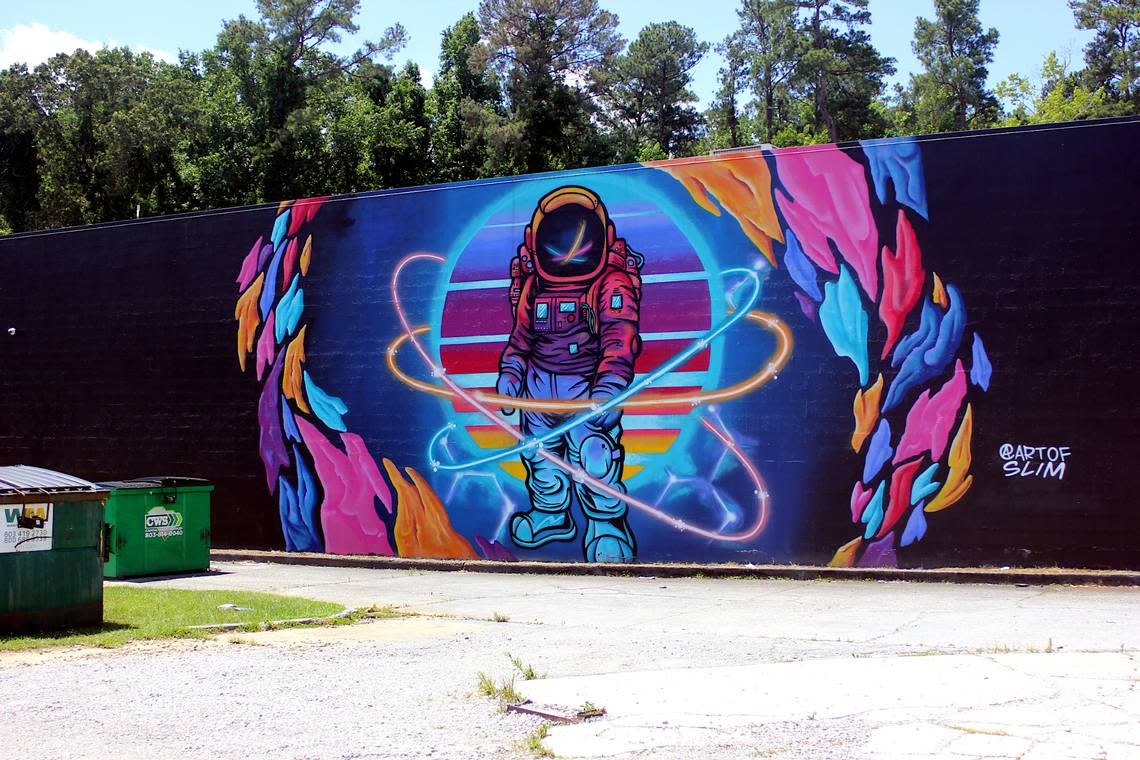Art or ad? Midlands city debates vape shop astronaut as it considers mural program

“Just lonely and misunderstood.”
That’s how West Columbia Mayor Tem Miles jokingly described the astronaut whose neon-painted presence on the side of a vape shop has become a point of at least some controversy as city leaders consider whether and how to encourage more murals across the growing city.
West Columbia City Council discussed at a June meeting a possible mural program that would connect artists with local businesses looking to fill blank walls, with the city finding a way to pick up the tab to add more color to its landscape.
But that discussion turned frequently to one particular mural, the aforementioned astronaut, painted on a wall at the Sunset Court shopping center, facing out toward a busy corridor of Sunset Boulevard/U.S. 378. On the other side of that wall is Planet Vapor. The first of two locations of the local chain in West Columbia, it’s one of a handful of vape shops that have taken up residence recently along the city’s stretch of Sunset Boulevard.
The mural was a point of controversy when it went up a couple years ago, with City Councilman Jimmy Brooks helping lead a charge of neighborhood complaints. Brooks was again vocal about his disapproval of the astronaut, painted by Columbia-born artist Austin “Slim” Gee.
And as the city now considers encouraging more murals on more businesses, Brooks has expressed concern for how these artistic expressions will be overseen going forward.
“I think we need to make sure we do murals that are relevant to what West Columbia is, and we don’t allow anything that appears to be advertising,” Brooks told The State. “And unfortunately, I think we allowed one of those to go in on 378. It’s very questionable whether it’s advertising or not. And I think we need to make sure it’s got something to do with the history of West Columbia or something relevant. And I’ll say it: Not an astronaut on the side of a vape building that calls itself Planet Vapor.”
The mural doesn’t refer to the business beyond the perception that the celestially inspired image is meant to draw people into Planet Vapor. The company, which didn’t respond to requests for comment, does feature the same image of the astronaut prominently at the top of its website.
Brooks noted that the astronaut was initially tagged “#planetvapor803” before the city forced a change to the artist’s signature. West Columbia issues permits for murals and advertising signs separately.
Miles pooh-poohed the notion that the mural is a direct advertisement for the vape shop.
“They say that the astronaut is too closely related to the name of the business,” the mayor said. “The astronaut is literally in outer space, which is, by definition, the furthest place you can be away from a planet, right?”
The conflict over the astronaut could help shape how West Columbia handles setting up its potential mural program, which is still in the early stages. How the project would be funded and how much it would cost remain up in the air, with Miles suggesting the city could tap into hospitality tax dollars, which are meant to pay for tourism-related initiatives.
“We’ve got to look and see which pot of money that program meets the parameters of,” he said.
Murals have been a big part of beautification improvements in the city’s increasingly bustling River District along State Street, and members of City Council agreed that the mural program could help expand those artistic efforts to other parts of the city.
The discussion earlier this month centered on a question from City Councilman David Moye about whether the city should set up a commission to handle the business of selecting artists and mural proposals or if those decisions should be left to staff and council.
Brooks made clear he doesn’t want to see a commission control the program without oversight.
“I think once you put a bunch of people that are artsy and have all these different opinions, we need to make sure it’s not anything that goes at all cost,” he said during the meeting.
Asked about the need to have some control over the murals that go up in the city, Brooks said that’s a potential benefit he sees with the city starting the program. While it can’t limit the free expression of businesses that want to add a mural, it can incentivize them to go with murals leaders approve of by offering to pay for them.
Miles agreed that if the city is going to pay for murals, it should have some say in what they end up looking like, but he said he wants to make it clear that businesses are free to express themselves.
“I don’t want this to be a deal where we’re taking away people’s property rights to engage in artistic expression more than we currently are,” he said. “So certainly I feel like if we’re if we’re putting up money and being a part of this, we need to have some say and control in the outcome, but I don’t want that process to kind of morph into a deal where we use it as a means to prohibit people and further restrict folks’ property rights on their own private property for privately funded projects.”
Moye focused on the mural project’s potential to affordably enhance the city’s ongoing beautification efforts.
“What’s great about a mural program is it enhances our facade grant program because we can draw money for public art from different sources,” Moye said. “That gives us different avenues of finance. And a mural is probably the easiest way to make the largest impact with the smallest budget in the shortest amount of time.”


